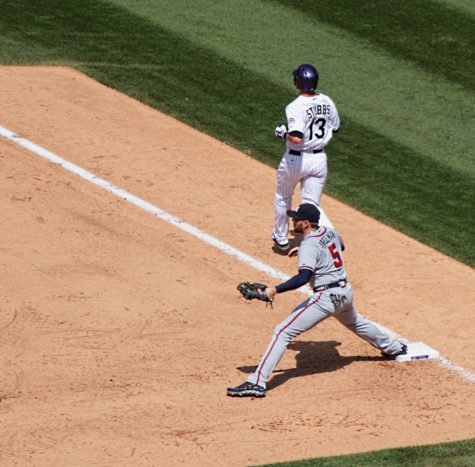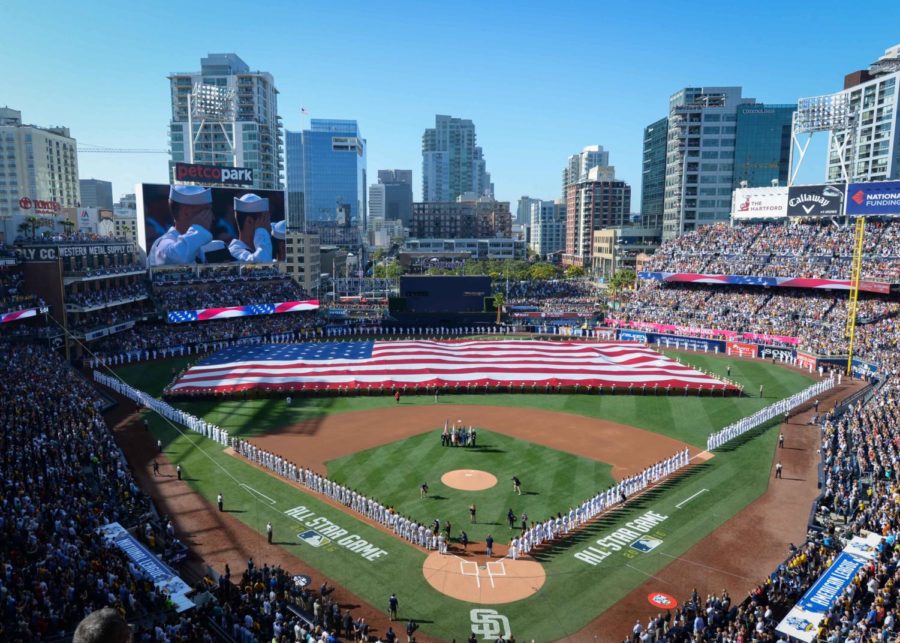Baseball implements new rules into Minor Leagues
Used from Flickr by U.S. Pacific Fleet under Creative Commons
2016 All-Star game at Petco Park. Baseball is a special game that brings about people from all over the world. Recently, Major League baseball brought about new rules into the minor leagues.
April 23, 2021
Baseball has returned and fans have enjoyed the sensation of being in a ballpark after last season. The pandemic has called for new policy changes; however, there are changes that one wouldn’t expect. Major League Baseball has started to implement different styles of the game in the minor leagues with hopes to influence younger audiences to watch America’s favorite pastime. Major League Baseball has split each of these rule changes amongst the different classes- sections of Minor League teams depending on region, competitiveness, and experience- to avoid mass change during the experimental phase.
1) 15-Inch Bases Expand to 18 Inches

Class AAA will expand the sizes of the bases from 15 inches to 18. This rule is a great way to protect player’s from injury via tripping or players cleating each other. For too many years, first basemen have gotten injured due to collisions and cleaning. Bigger bases should make their way up to the major leagues faster than expected. Raul Ibanez, a popular slugger, expands on this idea.
“Historically, guys who were first basemen put their foot on the side of the bag; they extend their range and work to their backhand side,” says Ibanez. “Now, if you go back and look at the Aguilar play — you see a lot more of this today than ever before, guys with their back heel up instead of getting on the side of the bag.”
Ibanez talks about how players in the majors now have been trained to play first base. They did not grow up that way. For example, Braves All-Star, Freddie Freeman, grew up a pitcher and third baseman but now is their primary first baseman. The league could even adopt a double bag. One bag is dedicated to the runner and another for the defensive player. These players come up as second baseman and third basemen but first involves different mechanics. Shown in the picture on the right, Freddie places his ankle on the side of the bag, making his ankle susceptible to injury. With this new bag, there is more room for both the runner and the first baseman. Bigger bags will positively benefit the league and players by reducing first base collisions small injuries. It is something that the league should have looked at a while ago in order to prevent unnecessary injury.
2) Pick-Off Changes
Class A baseball has new rule changes involving pick-off throws. This rule states that a pitcher must step off the rubber before throwing a pick. Pitchers are also only allowed two pick-off throws. If they go over two, then the third must result in an out or it is a balk- an illegal pitching motion. The league is trying to speed up games, but this rule is too restrictive. Limiting pick-off throws takes away a key component of excitement in the game. To explain, cutting down the number of pick-offs allowed will have catchers in their heads about when the right time to call it is. Making pitchers stepping off the rubber is another rule that is not practical. Baserunners will be watching the pitcher’s feet and looking for that step off of the rubber. At that moment, there is no point in trying to pick off the runner. The speed of the game is important to viewers but this is not a rule that does not require changes.
3) Infield Shifting Changes
MLB enacted this rule in Class AA baseball. It requires four athletes to have their feet on the infield dirt. For example, the shortstop cannot be in shallow left field. Additionally, in the second half of the game, rules prevent infielders’ movement and two players must remain on each side of second base. Outfielders play in grass and infielders play in the dirt, that was how the game was created. The loss of infield shifts after the second half is a bit conflicting. Shifts are a big part of the game. The shift is a defensive strategy that is a sure out when the batter hits into the shift. Offensively, the shift is frustrating and limits the action within the game. Former President of Baseball Operations Michael Hill voiced his excitement for this new rule.
“You’re just trying to create more action and put more balls in play,” says Hill. “You’re opening up the field; without that guy in short right field anymore, you can hit a line drive there and know that you’ve got a hit.”
Overall, an open field allows for more defensive highlights. It brings back excitement and action into baseball games and requires more athleticism from the players. The shift rule is one that has two sides and it is hard to pick just one. It is worth giving up the shift for a more exciting game. It brings back skill and defensive style to the game. This rule will change the game for the better.
4) Automated Ball-Strike System (A.B.S.)
Low-Class A Southeast League will be using the ABS in future games this season. Though it is the farthest away from being brought up into the majors, this could be a huge improvement for the game of baseball; so people say. One of the catchers’ most important roles is taken out of the game, however, it keeps batters from adjusting and thinking on their feet. It will give the game more action, but it’s essential to think about the costs. The ABS will be adjusted to fit the strike zone, but it will take away jobs and important aspects of the game that are not ready to be given up. As crazy as it sounds, the feud between umpires, fans, and players is such an important part of baseball and sports in general. It gives the game life and excitement. Also, the catcher’s framework is another important aspect, and taking that away would be disappointing. Ultimately, taking away the umpires takes away the life from the game.
5) Field Timers to Move Games Along
Baseball has been talking about having running game clocks for a while. It limits the amount of time between pitches, innings, and pitching changes. In connection to other sports, football has a game clock with a maximum amount of time between plays and it helps keep the action going. The play clocks could be a good thing for both pitchers and hitters and they will keep the attention of fans.
Baseball is a game known for its long duration and the recent loss of younger viewers and MLB is combating these with new rule changes. Though made to increase viewership, most of these rules will positively impact players as well. Change is difficult to accept sometimes, but after much contemplation, it is important that these rules are tested. It is a way to better the game that millions of people worldwide appreciate.





